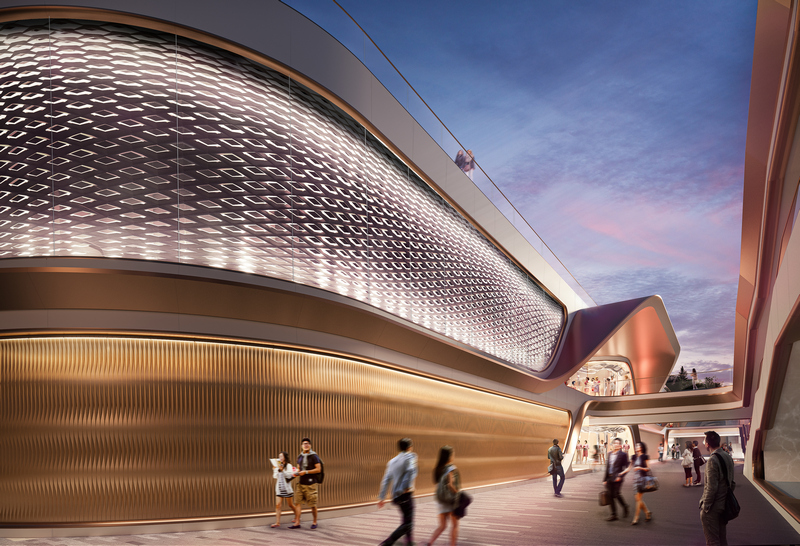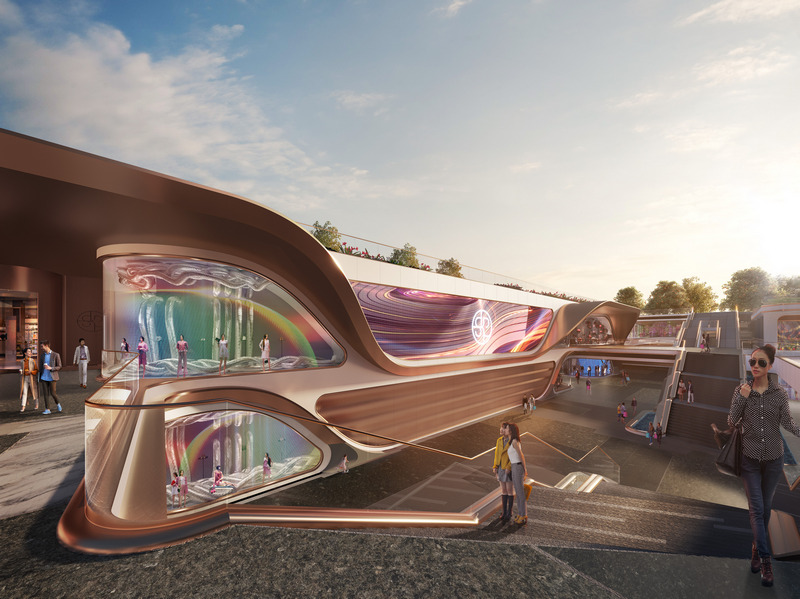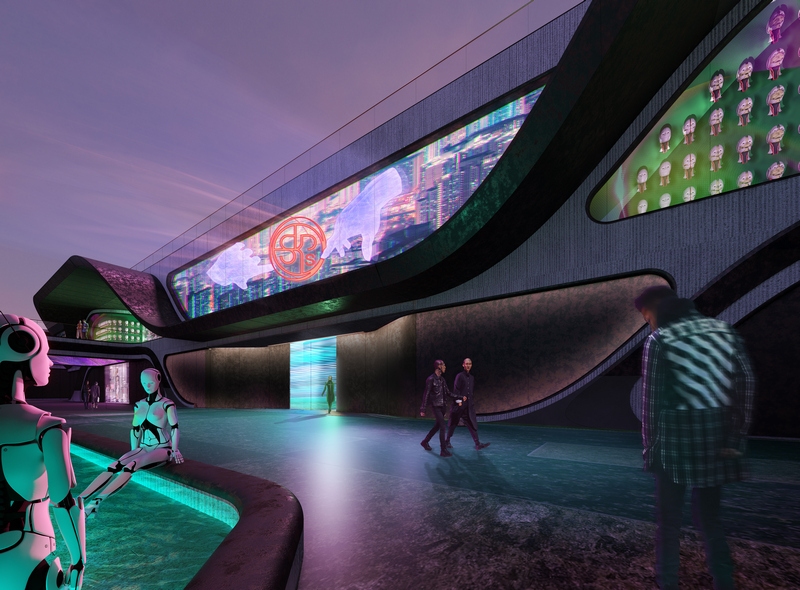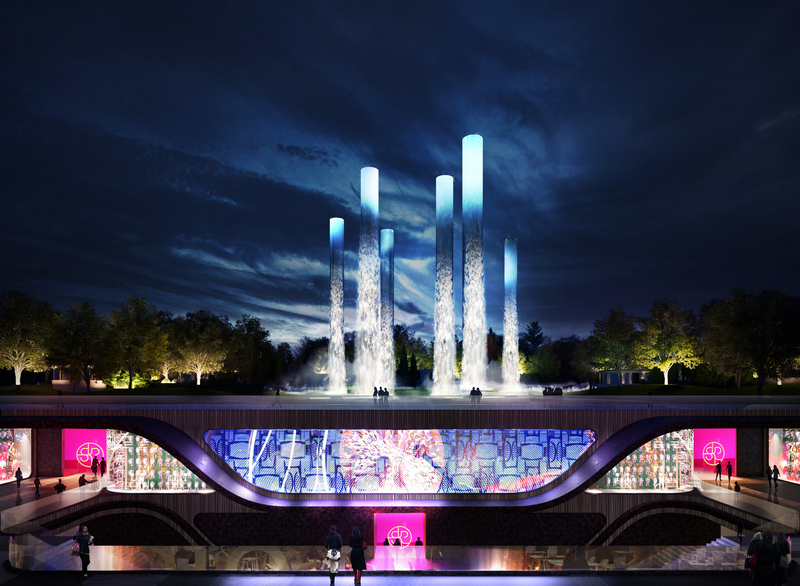Located in Chengdu, Sichuan Province, China, the development is part of the SKP chain of high-end shopping centres, which also includes locations in Beijing and Xi’an. Featuring a wide range of luxury brands and designer stores, it also offers a plethora of dining options, a cinema and a series of different parks atop the structures, described as a “botanical patchwork quilt”. In addition to its luxurious shopping experience, SKP Chengdu is garnering a reputation for its unique architectural design, establishing itself as a recognisable landmark in the city.
Comprising half a million square metres of retail space, this biophilic masterplan is a holistic and collaborative design, realised by Sybarite with SKP Operators, James Corner Field Operations, Eckersley O’Callaghan, Arup, Speirs Major, Buro Happold and The Fountain Workshop over a three-year period.
A new blueprint for luxury retail
Conceived as a place with an undeniable sense of interconnectedness – a combination of urban parks, sunken spaces and shopping avenues – SKP Chengdu is a TOD (Transit Oriented Development) and as such creates dense, walkable, and mixed-use spaces near transit hubs that support the development of vibrant, sustainable and equitable communities.
With 99 percent of the buildings below ground level, the store is divided into four main areas: Chengdu SKP, Chengdu SKP-S, K Avenue and G Avenue. At ground floor level, only a few pop-up stores are visible interspersed amongst 33 crafted landscapes and scenic spots.
The multi-level store is anchored by the SKP department store at the north and the future-focused SKP-S department store at the south, which is topped by six towering water-fountains, known as ‘The Towers of Life’, that reach up to 36 metres high. A sequence of pavilions, which house key luxury brands, is flanked by these two anchor stores, and separated by canyon-like walkways that are crossed by angled pedestrian bridges. At the centre of the park is a bamboo garden contained within a glazed Central Cube, which provides light and access to the shopping levels below ground.
Eckersley O’Callaghan, an award-winning firm with an international reputation for its creative yet rigorous approach to engineering structures and facades, worked in close collaboration with Sybarite to develop and design the intricate facade elements, structural glass features and advanced engineering of many structures around the development – crafting an environment that is both visually stunning and highly functional.
Beneath the surface
The design of the facades plays an important role in alluring visitors and act as a visual signifier embodying the values of the SKP brand. Distinctive and complex, they are characterised by a unique mix of materials (brushed brass, pearlised aluminium, fritted glass) and coded motifs (curves, canopies and façade ‘origami’ back walls).
This was the second time Eckersley O’Callaghan worked with Sybarite for SKP after their successful involvement in SKP Beijing. For SKP Chengdu, they engineered the facades and canopies in the main entrances of the two department stores (SKP and SKP-S), the glazed Central Cube, the SKP glass box, the circulation boxes and the Y-shaped pedestrian bridge.
One the most challenging aspects of the project, was the development of the Central Cube which sits at the heart of the site and acts as a gateway into the shopping areas below. The cube consists of a central steel structure that cantilevers out to support the roof build up. A nine-by-nine metre skylight sits between the four main columns to provide light to the lower ground floor level. The cube is enveloped by a fully glazed facade, with a nine-metre opening on the front face to facilitate circulation.
The roof structure of the cube is supported through the four tapered steel columns that are fixed back to the underground level. It has been designed to integrate a water feature at its crown, creating the illusion of a linear glass waterfall which offers an experiential route for visitors, as they walk through surrounded by the calming water. Ensuring the steel structure could accommodate the necessary services, whist remaining lean and refined, required a considered approach.
Stability for the Central Cube from unbalanced horizontal winds and seismic loads was a strict requirement – to avoid torsion. A traditional approach to tackle this would have been to introduce concrete shear walls, cross braced steel bays, or heavy moment frames – all of which would have detracted from the desired simplicity and transparency.
Ian Langham, Director at Eckersley O’Callaghan, comments: “To lessen the structural demand of the central core columns, we utilised the glass to perform this function. This required detailed analysis and an in-depth understanding of the interaction between the steelwork and glass system, as well as careful envelope detailing to transfer horizontal loads whilst at the same time facilitating vertical releases at the glass roof interface. This proved to be challenging within the limited space available to create the slender roof edge in order to achieve the architectural intent.”
Along with the Central Cube, the canopies, circulation boxes and pedestrian bridges all entailed complicated, non-standard, bespoke designs and required sophisticated, detailed analyses, studies and assessments to help realise their vision.
Ian continues: “Translating Sybarite’s concept into reality required a process of research and working collaboratively with the client, architect, fabricators and other consultants to overcome the never-been-done-before aspects of the design. Drawing from our extensive experience of projects in China, we were able to quickly adhere to strict design codes and regulations. This meant we were able to take a sensitive approach to design, with each innovative aspect having to prove its structural capabilities from first principles and by rigorous testing before approval.”
Architecture in motion
Torquil McIntosh, Co-Founder of Sybarite and spokesperson for SKP Chengdu, comments: “The approach to facades is layered to create a depth and three dimensionality which conveys a sense of architecture in motion. Sculpted entry canopies extend and cantilever up to three-metres beyond. A system was proposed for a curtain wall with glass panes and spandrel panels with all the solid cladding as ornamental attachments.
“The layers themselves encourage pattern, silhouette and a subtle play of light throughout the day. At night, facades pulsate with light and colour. The addition of digital panels within the facade allows the opportunity for dynamic content collaborations that are ever-changing and present a constant sense of newness. Sybarite did away with the traditional logo inscribed on the building, opting to integrate the SKP logo as a piece of the facade itself. This brand marque is underplayed in a way that the facades and architecture become an extension of the brand itself.” SKP Chengdu challenges every expectation, standard and rule of luxury retailing in terms of craft, quality, innovation, entertainment, engineering and sustainability. Its use of high-quality materials and innovative design techniques has helped to create a unique and memorable destination.




















